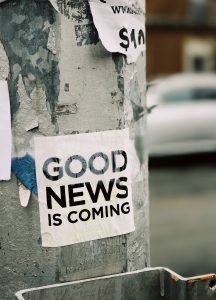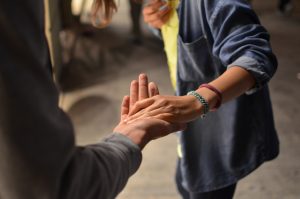Bearings
Practicing Gratitude as Healing
How do people who’ve been robbed of so much ever come to feel grateful for anything again?
By G. Jeffrey MacDonald
November 2017 Issue

As a rare breed of news reporter with divinity school training, I sometimes feel like I own the tragic violence beat. Editors send me in just as the TV news trucks are pulling out after a horrific event. When eerie stillness looms and survivors are crying out to God or to the abyss in the wake of disaster, I wipe away my own tears and straighten my tie in my car’s rearview mirror. Then I ring the doorbell, pull out my notebook, and listen.
This beat has kept me all too busy. I covered the 9/11 attacks, the Newtown shootings and the Boston trials of mobster Whitey Bulger and Marathon bomber Dzhokhar Tsarnaev. With each assignment, I’ve wondered, how do communities heal from violence? How do people who’ve been robbed of so much—a child, a leg, a life before PTSD—ever come to feel grateful for anything again?
Answers to these kinds of questions sometimes take years to surface. But when they do, they bring hope—not only for victims but for everyone else, too. Observers rightly note that if people who’ve lost so much can feel deeply grateful again, then perhaps the rest of us can rise with grateful hearts above the injustices and regrets that mark our pasts. Perhaps the gratitude-enhancing practices of deeply wounded people can be a trove of wisdom for a bruised and bruising world.
Here’s what I’ve learned. Violence-scarred communities can and sometimes do heal through paradoxical practices that build up gratitude. Healing happens as resilient survivors turn outward when they feel like turning inward; when they give of themselves even after a part of them has been torn out; when they come to understand their wounds not as festering cesspools but as wellsprings of potential benefit for others.

“We have found that people who hold a religious value and belief, and are engaged in a religious community, are more likely to experience post-traumatic growth,” said Robert Neimeyer, a psychologist who studies healing after murders at the University of Memphis. Another group that also tends to experience this type of growth are people who’ve suffered the most tragic of losses, such as a child’s death or a loved one’s violent death.
“Both of these seem to be positive predictors…of greater wisdom, greater compassion, greater altruism, more valuing of life,” Neimeyer told me.
Neimeyer said he’s seen extraordinary personal growth happen again and again after a violent episode. But manifesting that capacity is by no means guaranteed. It often comes to fruition as a person draws on his/her experience of particular hardship and uses it to help someone else.
Heather Abbott has lived the phenomenon that Neimeyer studies. She was with friends at a bar near the Boston Marathon finish line in 2013 when the second bomb exploded, knocking her to the ground where she almost died from blood loss. After four days in the hospital, she made the wrenching decision at age 38 to let doctors amputate her leg.
The adjustment has, of course, been extremely difficult. But Abbott was determined not to turn inward or let self-pity color her life. She founded the Heather Abbott Foundation to raise money to help amputees get specialty prosthetic devices, which can cost up to $100,000 and are not covered by insurance. In this work, she’s leveraging her platform as a Marathon bombing survivor to help in a way that grows directly from her worst experience—just like the subjects who fare best in Neimeyer’s studies.
“I felt like, when this happened to me, that there must be some reason why it happened,” Abbott told me in her Newport, R.I. apartment almost a year after the bombing. “I don’t know what that reason is. But I know that, so far, it’s provided me with a chance to help other people, which in turn helps me. It helps me feel better about what happened.”
Others attest to similar dynamics in their experiences. Isolation and despair took a toll earlier this year on Lynn Wencus of Wrentham, Mass., who lost her 33-year-old son, Jeff, to an opioid overdose in February.
But her grief-filled spot of deepest pain has given her a new capacity to encourage others with loved ones caught up in the epidemic. She has recently connected with a mother who, Wencus says, needs the same reassurance that the Wencus family needed a year ago but didn’t get from the community. She needs to know she’s loved, she’s not a parental failure and she’s not alone.
“Even if it’s just to say, ‘Hey, we can talk about this, let’s not be embarrassed…,’ I would be delighted to do that,” Wencus told me in October. “We have to get rid of the shame. We have to end the stigma.”
Those with less acute but still-painful situations also find that gratitude and healing can emerge from disciplines of service.
Those with less acute but still-painful situations also find that gratitude and healing can emerge from disciplines of service.For Cindy Hayes of Oxford, Conn., the weight of Newtown’s 2012 loss left her itching to do something positive. She began with 26 acts of kindness—one for each victim in the Sandy Hook Elementary School massacre. Example: nine days after the shooting, she and her daughter volunteered to help in the Newtown United Methodist Church nursery so that church members could attend worship. They did it in honor of murdered first-grader Olivia Engel. “I've purposefully been avoiding Newtown,” Hayes wrote in a December 2012 log. “This tragedy is painful enough, even a couple towns away. I didn't want to immerse myself in the middle of a grieving town. But these acts aren't about me, so we went.”
Helping in the nursery brought her some immediate comfort, she journaled, as “talking to the people of the town calmed my fears.” Over the next couple of years, her desire to serve people in need led to new commitments, including working at Abraham’s Tent, a homeless shelter in New Haven. She now teaches fifth grade at St. Martin De Porres Academy, a tuition-free Catholic middle school for low-income children in New Haven. Hayes now sees neighbor-loving disciplines as acts honoring her Creator. They’re all the more powerful, she says, when they override whatever personal difficulties are vying for her attention.
“We are showing our appreciation to God,” Hayes said in an October email. “He has placed the gift of love in each of our souls. What better way to show gratitude for that gift than to share it with others?”
Not all communities or individuals are able to make the counterintuitive turn toward generosity and agapic love in the wake of tragedy. Protracted grief, compounded by anger, bitterness and a sense of unresolved injustice, can burn and indefinitely consume those who turn inward and find no positive outlets for their experiences, according to Neimeyer.
But for those carrying burdens into the holidays, the invitation to healing still beckons. Signposts for selfless service and a grateful heart mark the way.
"Helping others helps people adjust to deeper questions of a tragedy's purpose,” said Tom Johnson, co-founder of the Center for the Study of Health, Religion and Spirituality at Indiana State University in Terre Haute. “They say, 'At least I can work for light, work for the good, do something to reduce the likelihood of it happening again.'"
In this sense, gratitude is an attitude, but more than that, it’s an active process of transformation. It’s living life after tragedy, after trauma, as an ongoing practice of hope—however shaky—and purpose that embody a deep appreciation for our own fragile, blessed lives, for the lives of others, and the life of the planet we share.
Photo Credits:
Cover image: Matthew Smith, "Yellow Forest Flower." Via Unsplash. Cropped. CC2.0 license.
Inside image 1: Jon Tyson, "Good News is Coming." Via Unsplash. CC2.0 license
Inside image 2: Rémi Walle, Untitled. Via Unsplash. Cropped. CC2.0 license.


